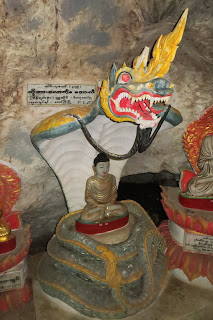The Pindaya Caves located next to the town of Pindaya, Shan State, Myanmar (Burma) are a Buddhist pilgrimage site and a tourist attraction located on a limestone ridge in the Myelat region.
The area is part of the ancestral homeland of the Danu people.
There are three caves on the ridge which runs north-south, but only the southern cave can be entered and explored. It is not known whether the other two penetrate for any extended distance into the hillside.
|
Pindaya Caves seen from the northeast. |
|
Approaching the Pindar Caves from the south. |
|
Set of statues representing a line of monks carrying their alms
bowls. |
|
Sculptures of the spider and the prince aiming with his bow.
|
|
Buddha sculpture protected by Mucalinda.
|
|
Entrance to the covered staircase that leads to the cave. |
|
Detail of one of the dragons. |
|
Yan Aung Myin - Htu Par Yone Pagoda. |
|
Hsaungdan (covered stairway) to the caves. |
|
Shwe U Min Natural Cave Pagoda Site Plan. |
|
Poster with the 31 Bhumis - Stage of being.
|
|
Entrance to the cave. |
|
White Buddha protected by Mucalinda on the right side of the
entrance. |
|
Golden stupa at the entrance to the cave. |
|
Golden Buddha at the entrance to the cave. |
|
Well-worn path. |
|
The Maze.
|
|
The Meditation Cave. |
|
Descending towards the deepest parts of the cave. |
|
The deeper parts of the cave are darker and wetter. |
|
Small Buddha protected by a large Mucalinda. |
|
Pagoda in one of the deepest areas of the cave. |
|
Victory column.
|
|
General view of the deepest room in the cave. |
|
Walking the path in the deepest part of the cave. |
|
Buddha protected by Mucalinda with green and yellow bands. |
|
Buddha protected by two snakes. |
|
Peaceful Buddha protected by Mucalinda. |
|
Some Buddhas are protected by umbrellas.
|
|
Some Buddhas are dressed in cloth clothes. |
|
Buddha protected by Mucalinda with pink hood. |
|
Buddha protected by a blue Mucalinda. |
|
Perspiring Statue. |
|
Nat spirit of the cave. |
|
Leaving Pindaya Cave. |
See also
-
Buddhist Rock Temple
-
Banyan Trees of Pindaya
-
Aung Traditional Paper Umbrella Workshop
-
Pindaya Survival Kit
Source
Location




































































